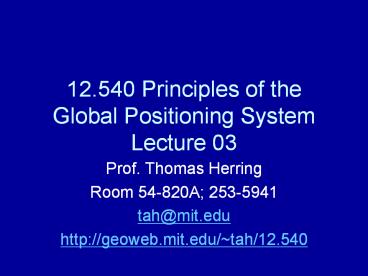12.540 Principles of the Global Positioning System Lecture 03 - PowerPoint PPT Presentation
1 / 27
Title:
12.540 Principles of the Global Positioning System Lecture 03
Description:
In spherical coordinates solved by separation of variables, r=radius, ... – PowerPoint PPT presentation
Number of Views:142
Avg rating:3.0/5.0
Title: 12.540 Principles of the Global Positioning System Lecture 03
1
12.540 Principles of the Global Positioning
SystemLecture 03
- Prof. Thomas Herring
- Room 54-820A 253-5941
- tah_at_mit.edu
- http//geoweb.mit.edu/tah/12.540
2
Review
- In last lecture we looked at conventional methods
of measuring coordinates - Triangulation, trilateration, and leveling
- Astronomic measurements using external bodies
- Gravity field enters in these determinations
3
Gravitational potential
- In spherical coordinates need to solve
- This is Laplaces equation in spherical
coordinates
4
Solution to gravity potential
- The homogeneous form of this equation is a
classic partial differential equation. - In spherical coordinates solved by separation of
variables, rradius, llongitude and
qco-latitude
5
Solution in spherical coordinates
- The radial dependence of form rn or r-n depending
on whether inside or outside body. N is an
integer - Longitude dependence is sin(ml) and cos(ml) where
m is an integer - The colatitude dependence is more difficult to
solve
6
Colatitude dependence
- Solution for colatitude function generates
Legendre polynomials and associated functions. - The polynomials occur when m0 in l dependence.
tcos(q)
7
Legendre Functions
- Low order functions. Arbitrary n values are
generated by recursive algorithms
8
Associated Legendre Functions
- The associated functions satisfy the following
equation - The formula for the polynomials, Rodriques
formula, can be substituted
9
Associated functions
- Pnm(t) n is called degree m is order
- mltn. In some areas, m can be negative. In
gravity formulations mgt0
http//mathworld.wolfram.com/LegendrePolynomial.ht
ml
10
Orthogonality conditions
- The Legendre polynomials and functions are
orthogonal
11
Examples from Matlab
- Matlab/Harmonics.m is a small matlab program to
plots the associated functions and polynomials - Uses Matlab function Legendre
12
Polynomials
13
Sectoral Harmonics mn
14
Normalized
15
Surface harmonics
- To represent field on surface of sphere surface
harmonics are often used - Be cautious of normalization. This is only one
of many normalizations - Complex notation simple way of writing cos(ml)
and sin(ml)
16
Surface harmonics
Zonal ---- Tesserals ------------------------Sect
orials
17
Gravitational potential
- The gravitational potential is given by
- Where r is density,
- G is Gravitational constant 6.6732x10-11
m3kg-1s-2 (N m2kg-2) - r is distance
- The gradient of the potential is the
gravitational acceleration
18
Spherical Harmonic Expansion
- The Gravitational potential can be written as a
series expansion - Cnm and Snm are called Stokes coefficients
19
Stokes coefficients
- The Cnm and Snm for the Earths potential field
can be obtained in a variety of ways. - One fundamental way is that 1/r expands as
- Where d is the distance to dM and d is the
distance to the external point, g is the angle
between the two vectors (figure next slide)
20
1/r expansion
- Pn(cosg) can be expanded in associated functions
as function of q,l
21
Computing Stoke coefficients
- Substituting the expression for 1/r and
converting g to co-latitude and longitude
dependence yields
The integral and summation can be reversed
yielding integrals for the Cnm and Snm Stokes
coefficients.
22
Low degree Stokes coefficients
- By substituting into the previous equation we
obtain
23
Moments of Inertia
- Equation for moments of inertia are
- The diagonal elements in increasing magnitude are
often labeled A B and C with A and B very close
in value (sometimes simply A and C are used)
24
Relationship between moments of inertia and
Stokes coefficients
- With a little bit of algebra it is easy to show
that
25
Spherical harmonics
- The Stokes coefficients can be written as volume
integrals - C00 1 if mass is correct
- C10, C11, S11 0 if origin at center of mass
- C21 and S21 0 if Z-axis along maximum moment of
inertia
26
Global coordinate systems
- If the gravity field is expanded in spherical
harmonics then the coordinate system can be
realized by adopting a frame in which certain
Stokes coefficients are zero. - What about before gravity field was well known?
27
Summary
- Examined the spherical harmonic expansion of the
Earths potential field. - Low order harmonic coefficients set the
coordinate. - Degree 1 0, Center of mass system
- Degree 2 give moments of inertia and the
orientation can be set from the directions of the
maximum (and minimum) moments of inertia.
(Again these coefficients are computed in one
frame and the coefficients tell us how to
transform into frame with specific definition.)
Not actually done in practice. - Next we look in more detail into how coordinate
systems are actually realized.































